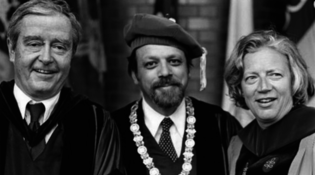 loading
loading
From the EditorHanna Gray's extraordinary lifeIn a new memoir, Yale's first woman president looks back--and forward.  Manuscripts and ArchivesHanna Holborn Gray (right), newly appointed president of the University of Chicago, poses with her predecessor at Yale, Kingman Brewster Jr. ’41 (left) and her successor A. Bartlett Giamatti ’60, ’64PhD (center), at Giamatti’s inauguration in 1978. View full imageThere’s a lot that is extraordinary about Hanna Holborn Gray. It’s not just that she was the first woman to serve as president of Yale and the first to serve as president of any of the Ivies. It’s not just her exceptional intellect and administrative skills, her family’s emigration to escape the rise of the Nazis, or her dry sense of humor, all of which surface in her new memoir, An Academic Life. It’s also this: not once in the text does she mention that she was awarded the Presidential Medal of Freedom. All Gray provides is a one-line caption accompanying one of several photos: a snapshot of herself and her husband with George H. W. Bush ’48 and his wife, on the date Bush bestowed the medal. (And I suspect her publisher insisted on printing both photo and caption.) It’s hard to tell which is more impressive, the medal or her modesty about it. Gray’s memoir is a clear, incisive recounting of subjects she cares about: her family, academia, the places she lived and worked that meant the most to her. She was born in Heidelberg, Germany, in 1930. Both of her grandfathers were academics; both of her parents had PhDs. But in 1933, Hitler became chancellor. Gray’s mother was Jewish and her father had publicly criticized Nazism, and they “found the handwriting on the wall perfectly legible.” Her father emigrated to start the search for a post abroad, eventually securing one at Yale. Gray grew up in the New Haven area. She went on to college at Bryn Mawr and graduate school at Harvard for a PhD in early modern European history. At Harvard, she met her future husband, Charles Gray. Hanna Gray notched at least nine academic “firsts,” from first female teaching fellow at Harvard to first female provost of Yale, first female president of Yale, and first female president of the University of Chicago. She was a born administrator. On her very first day as Yale provost, she writes, “an agitated assistant professor rushed in. He complained loudly and colorfully that he had just been bitten by a colleague, pointing as ‘proof’ to an invisible mark on his arm. . . . I had, of course, learned to expect the unexpected, but this was new territory.” Gray knew what to do: she put the department into receivership. She would help smooth faculty relations in many other areas, as when she moved a professor out of his department and had him report directly to the provost’s office. “Provosts and deans have a lot of pastoral work to do,” she observes. After Kingman Brewster ’41 retired as Yale’s president, Gray experienced a year that “taught me that you can survive anything.” She was interim president—but also still provost; the union struck for 11 weeks; and it was clear to her that, although she’d been interviewed for the Yale presidency, Yale was not going to appoint a woman (especially a non-Yale woman). But then the University of Chicago came calling. She would be president there for 15 years, with great success. The Medal of Freedom came soon after she stepped down and returned to teaching. Like every good administrator, Gray is still looking ahead. At end of the book, she considers the state of academia today and her hopes for it: “Academic freedom is at its strongest when it can flourish in an environment of political freedom. The belief that universities should be, above all, the homes of searching and critical intellectual vigor and thought needs recurrent renewal and reaffirmation.”
The comment period has expired.
|
|